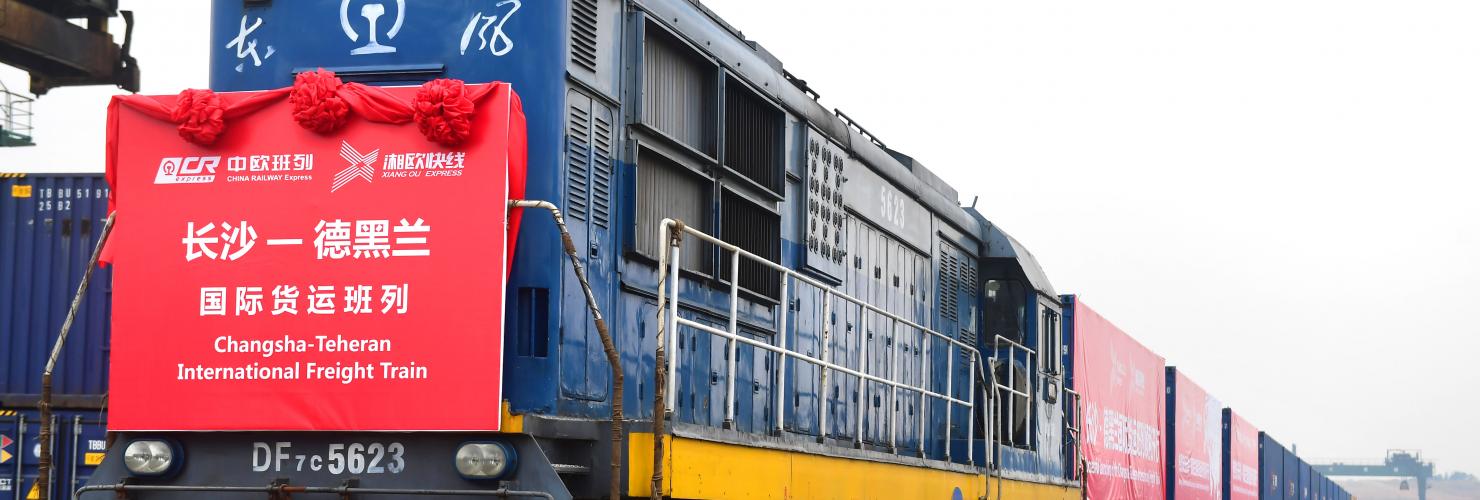

Responding to China’s Belt and Road Initiative: Two steps for a European strategy
The Belt and Road Initiative (BRI) promises to advance global development but also carries daunting risks. If left unchecked, the project could both challenge EU cohesion and undermine European standards. The EU needs the institutional capacity to assess these risks and a coherent narrative to compete with China's. This article is part 1 of a mini-series to present the outcomes of the MERICS European China Talent Program 2018.
The BRI has contributed to the creation of an impressive network of infrastructure across Asia, Europe and Africa over the past five years. Some EU member states have welcomed Chinese investment with open arms, while others have been more vocal in their criticisms of the initiative.
As China charges ahead, it is time for the EU to come up with a unified evaluation and response. The EU needs a better mechanism to gather and exchange information on the BRI. It must also respond to the BRI by framing its own development projects within a more convincing narrative.
Over the past few months, many EU members’ previous wait-and-see approach appears to have evolved into an actively critical, or at least suspicious, standpoint. In an internal EU report leaked to Handelsblatt in April, 27 out of the 28 EU ambassadors in Beijing signed their support for the statement that the BRI “runs counter to the EU agenda for liberalizing trade.” A few months earlier, top-level officials from the EU, Germany and France had called for a joint response to the BRI. In Brussels, a white paper on crafting a competitive European approach to connectivity in Eurasia is currently in the making.
Danger of economic and political dependencies
The shift in European attitudes seems to stem primarily from a realization of the risks associated with the BRI. Firstly, the political influence that Beijing accrues from investments in Europe is seen as serious challenge to EU cohesion. Last year, Greece vetoed a joint EU human rights statement on China, and in 2016, Greece and Hungary joined hands to avoid criticizing China in a joint statement on territorial issues in the South China Sea.
Another significant source of concern is that several countries along the BRI are already becoming heavily indebted to China – a point emphasized by IMF top official Christine Lagarde in April.
These worries about unsustainable financial situations are also linked to misgivings over political strings attached to Chinese economic support. China has on several occasions leveraged its economic capacity to take control of strategically important infrastructure, and Beijing has long demonstrated a willingness to use economic statecraft to exert political pressure abroad.
Even under the assumption that BRI is purely motivated by the pursuit of common prosperity, it is doubtful that BRI projects would be implemented according to the high environmental, social, and economic standards that Europe would like to see proliferate in global development.
To better assess and contain risks emerging from the BRI, the EU can do two things, both of which come at a relatively low cost. First, Europe needs to build a solid understanding of the BRI and actively attempt to establish a common position. Second, the EU has to become better at marketing its existing development programs, which are often eclipsed by the hype surrounding BRI.
Step 1: Intelligence gathering and coordination
Any meaningful policy discussion starts with establishing a common understanding of the facts. For EU member states seeking to understand the BRI, information about Chinese infrastructure projects and business activity is often hard to come by. To bring all EU members to the same information level, therefore, requires a mechanism for information-sharing and coordination. European institutions such as the Council of the EU and the European Parliament are already making efforts to understand the BRI but such mapping exercises fall short of the permanent coordination mechanism that is needed.
Such a mechanism could be integrated into the European External Action Service (EEAS), which has EU delegations around the world. Drawing on the combined knowledge and competence of member states’ embassies and local networks, including think tanks, academia and businesses, EU delegations in priority BRI countries should be tasked with intelligence gathering.
New information should be fed back to the EEAS, which would maintain a public database on BRI projects. Ideally, such a database would include contractual details, timeframes, and financing arrangements, helping EU and third party decision makers to clearly assess the risks and opportunities associated with BRI. While the EU cannot directly steer Chinese investments, it can provide decision makers in third party and EU countries with the means to assess the quality of loans being offered by Beijing.
The EEAS would also be tasked with analyzing and coordinating member states’ positions toward the BRI, thus actively facilitating the process of reaching a common understanding within the EU.
Only minimal budget recalibrations would be necessary to establish such a mechanism, drawing as it would on the existing capacity of the EU and its member states. The additional budget allocations for coordination at the EEAS, meanwhile, would be a small price to pay for a deeper and shared understanding of a development project which promises to reshape the world’s economic architecture.
Step 2: Branding an alternative
The possibility of establishing an “alternative” to the BRI is being discussed in European policy circles. This discussion, however, overlooks the fact that an EU “alternative” already exists. The EU is already spending billions on infrastructure: within the EU through Cohesion Funds; regionally through mechanisms like the Instrument for Pre-Accession Assistance (IPA); and internationally through the European Investment Bank (EIB) and the European Bank for Reconstruction and Development (EBRD). The main problem is that these efforts are poorly marketed and need to be bundled more effectively, alongside the support of a powerful narrative.
Beijing has had much greater success with the BRI. Compare the popularity of the “New Silk Road” with the EU’s flagship infrastructure initiative, TEN-T. The Connecting Europe Facility (CEF) for Transport has made available 24 billion EUR in infrastructure finance across the EU, but its principal instrument, TEN-T, is virtually unknown to the public, even within EU borders. Meanwhile, the BRI is an omnipresent topic of discussion, both in foreign policy circles and in popular media.
The EU already contributes its fair share to development financing. What is lacking is a coherent narrative. To solve this problem, the EU should streamline and rebrand EU initiatives and development funds under a single identifiable label. When the BRI was announced, China incorporated projects that had been underway for years, if not decades, under the new Belt and Road umbrella. In much the same way, the EU could actively associate EIB and EBRD projects with its new brand.
This brand should be firmly anchored in EU priorities like transparency and sustainability. In contrast to Beijing’s vague “Visions and Actions” paper, Brussels should also articulate what such lofty sounding concepts mean in practice – i.e., transparent procurement processes and loan repayment under OECD rules.
Summing up, the EU is lacking both the institutional capacity to deal with the BRI and a coherent narrative to compete with it. To correct this, Brussels needs to adapt its bureaucracy to better understand the initiative and take steps to ensure that its own development model – based on sustainability and openness – is given greater coherence and visibility.
About the authors:
Viking Bohman is coordinator of the “Stockholm Belt and Road Observatory.”
Jacob Mardell is a project assistant at MERICS and founder of the blog "The China Road."
Tatjana Romig is a postgraduate student at the University of Heidelberg and co-founder of "Mapping China."
The authors participated in the fourth annual MERICS European China Talent Program in April 2018, during which parts of the argumentation presented in this blogpost were developed. The authors bear sole responsibility for the content.
